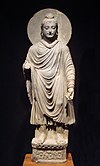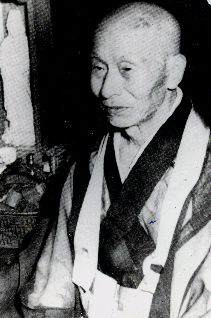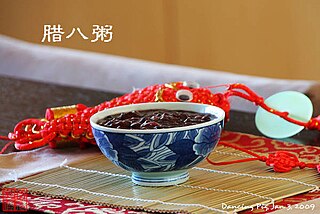Rōshi (老師) is a title in Zen Buddhism with different usages depending on sect and county. In Rinzai Zen, the term is reserved only for individuals who have received inka shōmei, meaning they have completed the entire kōan curriculum; this amounts to a total of less than 100 people at any given time. In Sōtō Zen and Sanbo Kyodan it is used more loosely. This is especially the case in the United States and Europe, where almost any teacher who has received dharma transmission might be called rōshi, or even use it to refer to themselves, a practice unheard of in Japan.
The Rinzai school is one of three sects of Zen in Japanese Buddhism.
In Zen-Buddhism, Dharma transmission is a custom in which a person is established as a "successor in an unbroken lineage of teachers and disciples, a spiritual 'bloodline' (kechimyaku) theoretically traced back to the Buddha himself." The dharma lineage reflects the importance of family-structures in ancient China, and forms a symbolic and ritual recreation of this system for the monastical "family".

Sanbo Kyodan is a lay Zen sect derived from both the Soto (Caodong) and the Rinzai (Linji) traditions. It was renamed Sanbo-Zen International in 2014. The term Sanbo Kyodan has often been used to refer to the Harada-Yasutani zen lineage. However, a number of Yasutani’s students have started their own teaching lines that are independent from Sanbo Kyodan. Strictly speaking, Sanbo Kyodan refers only to the organization that is now known as Sanbo-Zen International.

Taisen Deshimaru was a Japanese Sōtō Zen Buddhist teacher, who founded the Association Zen Internationale.
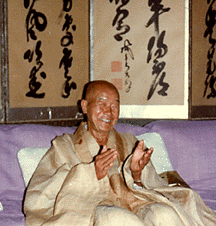
Sōen Nakagawa was a Taiwanese-born Japanese rōshi and Zen Buddhist master in the Rinzai tradition. An enigmatic figure, Nakagawa had a major impact on Zen as it was practiced in the 20th century, both in Japan and abroad.

Zen is the Japanese variant of Chan Buddhism, a Mahayana school that strongly emphasizes dhyana, the meditative training of awareness and equanimity. This practice, according to Zen proponents, gives insight into one's true nature, or the emptiness of inherent existence, which opens the way to a liberated way of living.
Eido Tai Shimano was a Rinzai Zen Buddhist roshi. He was the founding abbot of the New York Zendo Shobo-Ji in Manhattan and Dai Bosatsu Zendo Kongo-Ji monastery in the Catskill mountains of New York; he was forced to resign from that position of 40 years after revelations of a series of sexual relationships with and alleged sexual harassment of female students.

Hakuun Yasutani was a Sōtō rōshi, the founder of the Sanbo Kyodan organization of Japanese Zen.

Shodo Harada, or Harada Rōshi, is a Rinzai priest, author, calligrapher, and head abbot of Sōgen-ji — a three-hundred-year-old temple in Okayama, Japan. He has become known as a "teacher of teachers", with masters from various lineages coming to sit sesshin with him in Japan or during his trips to the United States and Europe.
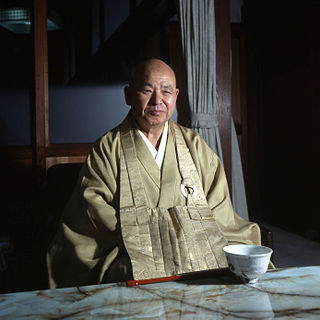
Keidō Fukushima was a Japanese Rinzai Zen master, head abbot of Tōfuku-ji, centered in Kyoto, Japan. Because of openness to teaching Western students, he had considerable influence on the development of Rinzai Zen practice in the West.
Michael Danan Henry is an American Roshi in the Harada-Yasutani lineage, a Zen sect derived from both the Rinzai and Sōtō traditions of Japanese Zen), practicing in the Diamond Sangha lineage of Robert Baker Aitken. The founding teacher of the Zen Center of Denver, Henry received Dharma transmission from Philip Kapleau Roshi in 1989 and was subsequently recognized as a Diamond Sangha teacher and master by Robert Baker Aitken. Danan Henry Roshi created and implemented the Monastery Without Walls training program; the Lotus in the Flame Lay Order; and the "Every Minute Zen" mindfulness practice as abbot and spiritual director of the Zen Center of Denver.
Zen institutions have an elaborate system of ranks and hierarchy, which determine one's position in the institution. Within this system, novices train to become a Zen priest, or a trainer of new novices.
Zen was introduced in the United States at the end of the 19th century by Japanese teachers who went to America to serve groups of Japanese immigrants and become acquainted with the American culture. After World War II, interest from non-Asian Americans grew rapidly. This resulted in the commencement of an indigenous American Zen tradition which also influences the larger western (Zen) world.
Zen lineage charts depict the transmission of the dharma from one generation to another. They developed during the Tang Dynasty, incorporating elements from Indian Buddhism and East Asian Mahayana Buddhism, but were first published at the end of the Tang.
Carlo Zendo Tetsugen Serra is an Italian missionary Soto Zen master, one of the last successors of Harada Daiun Sogaku . He founded his sangha, of the "Sangha della foresta di Bambü" and the monasteries Ensoji il Cerchio in Milan, and Sanbo-ji Tempio dei Tre Gioielli in Berceto. He also founded the "Scuola Zen di Shiatsu", that aims to use the art of shiatsu treatments as a zen practice. He is one of the buddhist religious authorities in Europe signator of the interreligious Italian "Manifesto della pace".

The zen monastery Enso-ji Il Cerchio refers to a buddhist community and a cultural association recognised by the Italian Government, according to Soto Zen Buddhism, founded by the Italian Zen Master Carlo Zendo Tetsugen Serra (1953-), He was disciple of the Japanese Zen Master Ban Tetsugyu Soin, between the late 1980s and the early 1990s. Later, he would be recognised as Zen Master in his lineage by his direct heir, the current abbot of Tosho-ji (東照寺), Tetsujyo Deguchi. "Il Cerchio Enso-ji" is also member of the Italian Buddhist Union (UBI), that collects in a federation the principal buddhist centers in Italy and of European Buddhist Union (EBU).
Tetsujyo Deguchi is a Japanese Zen master, successor of Ban Tetsugyu Soin.


